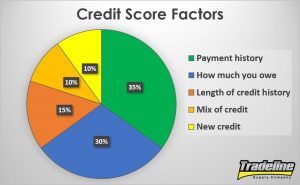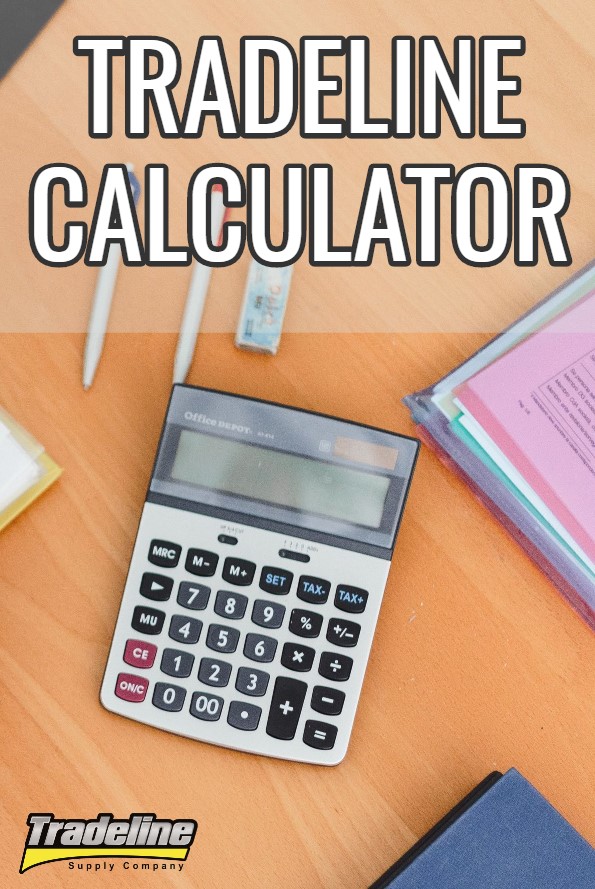How to Choose a Tradeline: A Buyer’s Guide
*Click here to check your utilization ratios and average age of accounts with our custom calculator!*
Understanding How to Choose the Best Tradelines
If you’re just starting out in the world of tradelines, we recommend taking a look at our Tradelines 101 infographic to get the basics down before moving on to deciding which tradelines to purchase. If you’re already familiar with the concept of tradelines and want to learn how to select the best tradelines for sale, then this buyer’s guide is for you.
When shopping to buy tradelines, there are basically only two main variables to consider:
(1) the age of the card, and
(2) the credit limit.
All the other variables should be about equal, which includes having a perfect payment history, low utilization (at or below 15%), the type of account (usually a revolving credit card), and the reporting date.
In most cases, if you buy from a reliable tradeline supplier, the name of the bank should not matter, except in instances where you may be blacklisted from that bank due to filing for bankruptcy or having unpaid collections with that bank.
So, with only two variables to consider, why is it so challenging to be able to choose the right tradelines? The answer is that most people’s credit files are fairly complex due to their depth of credit history. People have numerous data points in their credit file and all that data plays some sort of role in calculating their credit score.
Every person’s credit file is unique, making it very difficult to discuss how tradelines may affect anyone “on average.” Additionally, there are multiple different credit scores, each with their own closely guarded algorithm that takes into account a very large amount of data points within someone’s credit report.
When choosing the best tradelines for your situation, it’s not just about buying the top tradelines in terms of price. To get the results you want, you will need to understand what is already in your credit file and how adding tradelines could affect the important factors in your file.
Most people’s credit files contain a lot of complex information, which can make it difficult to predict how adding tradelines will affect one’s credit.
Credit Limits and Utilization Ratios
Let’s discuss each of these variables individually, starting with credit limits.
In most of the free credit score simulators out there, you can only change a very limited number of variables. So when it comes to trying to guess how a tradeline may affect your credit score, it usually only allows you to enter a new credit limit amount and then it generates a new credit score estimate.
The credit score simulator (sometimes referred to as a credit score calculator) assumes you are opening a new credit card with whatever limit you type in. Essentially, it is only looking at your overall utilization ratio, and not taking into account the age that you would gain from adding a seasoned tradeline.
As far as utilization, many professionals would suggest that you want to stay below 20% ideally. From our experience, we have seen that utilization ratios of 30% – 40% or higher start to pull credit scores down.
The higher the utilization ratio, the more your credit score will decrease, even if these accounts are always paid on time. Most credit specialists would recommend keeping your overall utilization ratio below 20% or even lower.
However, things get much more complicated in instances where someone has several credit cards with different utilization ratios.
Let’s say for example that someone has seven established credit cards, where two have zero balances, two are at 50% utilization, one is at 75%, and the last two are completely maxed out.
Sure, buying some tradelines with high limits might be able to get the overall utilization down to the targeted 20% level, but that does not eliminate the fact that that person still has five credit cards with high utilization, and each of these five cards is pulling down the credit score down due to high individual utilization.
Can a High-Limit Tradeline Help Lower Someone’s Overall Utilization Ratio?
In theory, a higher-limit tradeline can help lower someone’s overall utilization ratio, but this alone may not completely solve the problem of having credit cards with high utilization. Negative factors are always going to play a role in the credit score and having any high-utilization credit cards is a negative factor.
However, having a lower overall utilization ratio would be a positive change and may still yield some benefit despite the fact that the individual credit cards with high utilization will still remain in the equation.
We have even heard of metrics in the secret credit score algorithm that look at the percentage of high-utilization credit cards in someone’s credit file relative to the total number of credit cards they have.
For example, if someone has two credit cards, one with a $5,000 limit where they owe $5,000 on it and another credit card with a $25,000 limit where they owe zero on it, their overall utilization ratio is relatively low at 16.67% but they would be at 50% on the percentage of revolving accounts with high utilization. In this example, the 50% ratio of high utilization cards could possibly have a negative impact even though the overall utilization ratio is within the ideal range.
There may be other reasons why some people are interested in adding higher-limit tradelines to their credit file that have nothing to do with the typical goal of raising their credit score.
For example, some people believe that having higher-limit accounts in their credit file may increase their odds of getting approved for higher-limit credit cards or other types of loans. We do not have any knowledge about the validity of these beliefs, nor do we help people with funding in any way, but we are aware that such strategies exist in the marketplace.
This is an additional reason why some individuals might be interested in a high-limit tradeline even if there is not very much age on the account, which also makes the cost of a tradeline cheaper.
Examining the Age of a Tradeline
This leads us to the second variable to discuss, which is the age of the tradeline. We feel that age is the most important of the two factors of a tradeline. In general, a credit score is broken down into the following categories:
35% your payment history
30% how much you owe
15% length of credit history
10% credit mix
10% new credit
The utilization ratios fall under the “how much you owe” category, which accounts for about 30% of your score. Again, if you are only improving the overall utilization ratio but you are still being pulled down by individual card utilization ratios, then you may not be benefitting from the full 30% of the power of this category. Your benefit may be as little as 10-15% if you still have individual cards with high utilization ratios.
However, the tradelines we offer are going to have a perfect payment history, which is the category that can affect your score by as much as 35%. They also have the ability to affect the “length of credit history” category which accounts for another 15% of the score.
When added together, the payment history (35%) plus the length of credit history (15%) amounts to about 50% of a credit score. These two categories, which account for about 50% of a credit score, are both affected by the age of the tradelines.
This is why we believe age is the most important factor of tradelines, making “seasoned” tradelines the most valuable type.
“Seasoned” tradelines, or those that are at least two years old, are the most valuable type of tradeline.
In the age category, just like the utilization category, there are several different variables. To name a few, the credit score algorithm may look at your average age of accounts, the oldest account in your profile, the number or percentage of non-seasoned accounts (less than 2 years old) in your file as well as the number or percentage of seasoned accounts in your file.
Also, different scoring models may or may not include data on closed accounts and have varying degrees of how much weight they give to closed account information.
To illustrate an example, we have seen a credit report of a person who had over a 700 credit score with no open accounts at all. So 100% of that 700+ credit score was made up of data from closed accounts only.
We also know the opposite can be true, where someone has zero open accounts but several closed accounts with derogatory information and their credit score is very low, all from closed account data. So it is safe to say that closed accounts can still play a significant role in someone’s credit score since it is still part of their credit history.
One of the most important variables related to the length of credit history is the age of the oldest account in someone’s credit profile. This variable is very straightforward, except that it may be split into two categories: open accounts and closed accounts. It is assumed that open accounts usually weigh more than closed accounts and obviously, older accounts are better.
The most common age-related variable that most credit advisors will talk about is the average age of accounts. It is commonly believed that the average age of accounts may be the most powerful factor in the age category.
As we will see in the examples below, in working with tradelines, most people underestimate how difficult it is to significantly affect an average, especially when there are multiple accounts already in your credit history.
Calculating Your Average Age of Accounts
For illustration, here are a few hypothetical examples of how to calculate the average age of accounts and how new tradeline data gets factored in.
Example 1: Thin File for Simple Illustration
Card 1: 0.5 years old
Card 2: 0.5 years old
Card 3: 1.5 years old
The average age of accounts in this example is 0.83 years. The way you figure that out is to add up the total number of years and divide that by the total number of accounts. (0.5 + 0.5 + 1.5 = 2.5 years total, then divide by 3 = 0.83 years average.)
If your goal was to get the average age of accounts up to 2 years old by adding one tradeline, the new tradeline would have to be about 6 years old. (0.5 + 0.5 + 1.5 + 6 = 8.5 total years divided by 4 total accounts = 2.1 average age of accounts.)
Notice how much older the new tradeline had to be in order to simply get the average age of accounts to be 2 years old for a very thin file. Many people would not have guessed that they would need such an old card just to get the average to be 2 years old.
To illustrate this point, if someone were to only add a 4-year-old tradeline to this mix, the average age of accounts would then only be 1.6 years, and this is assuming a person only has 3 revolving accounts (opened or closed) in their credit file, which is very rare.
The more accounts a person has, the less impact a single tradeline will have due to the simple mathematics of calculating an average.
Example 2: Established Credit File With Multiple Open & Closed Accounts
The more accounts there are in your credit file, the more difficult it will be to affect the average age of accounts.
Card 1: 4 years old
Card 2: 8 years old
Card 3: 6 years old
Card 4: 4 years old
Card 5: 7 years old
Card 6: 7 years old (closed account)
Card 7: 15 years old (closed account)
Card 8: 13 years old (closed account)
Card 9: 9 years old (closed account)
Card 10: 12 years old (closed account)
The average age of accounts here is 8.5 years old. The way you calculate that is to add up the total number of years and divide that by the total number of accounts. (4 + 8 + 6 + 4 + 7 + 7 + 15 + 13 + 9 + 12 = 85 years, divided by 10 accounts = 8.5 years average age of accounts.)
Let’s say hypothetically that the person’s goal is to get their average age of accounts up to 10 years old by adding a single tradeline.
Please stop and take a moment to guess how many years old a new tradeline would need to be in order to make the average age of accounts 10 years in this example.
The Answer:
They would need to add a tradeline that is 25 years old in order to get the average age of accounts to be 10 years. (4 + 8 + 6 + 4 + 7 + 7 + 15 + 13 + 9 + 12 + 25 = 110 total years divided by 11 total accounts = 10 year average age of accounts.)
Notice how huge of a jump in years is needed in order to change someone’s average if they already have a lot of accounts in their credit file, even if some of them are closed accounts. Most people underestimate how difficult it is to really change an average and even most “professionals” (who are usually just commissioned salespeople) underestimate how these numbers actually work out.
Our tradeline calculator can help you figure out how buying tradelines could affect your credit.
Until you actually do the math yourself, do not just blindly trust what someone suggests for you. To easily calculate your own average age of accounts and utilization ratios and see how those variables change when you add seasoned tradelines, try our Tradeline Calculator.
A Common Mistake People Make When Buying Tradelines
It is easy to see how in the second example above, if this person did not do the math, they might purchase the wrong tradeline and be disappointed.
Let’s say they purchased a tradeline that is 18 years old with a $20,000 credit limit that cost $1,000. They might just assume that since it was an expensive tradeline with a lot of age and a high limit that it should “obviously” be super powerful and they should definitely see positive results.
However, in reality, the 18-year-old card would only increase the average age of accounts to 9.4 years, and it is very possible that increasing one’s average age of accounts from 8.5 years to 9.4 years may not have very much of an impact on their overall credit picture.
As you can imagine, this person could easily be very disappointed in their results for the reason that they simply did not do the math and were not aware of how to choose the best tradeline for their credit file.
As another example, what if this person were to choose to purchase a tradeline that is 7 years old with a $30,000 limit? On the surface, that might look like a decent tradeline to buy, but it would actually decrease their average age of accounts and consequently, it could even hurt their credit score, even though that tradeline might have a $750-$1,000 price tag.
We illustrate this to show that not knowing how tradelines work can actually hurt your credit and be a complete waste of money. For this reason, we believe education is the best service we can offer. Make sure to read our list of common mistakes made when buying tradelines to be aware of other pitfalls to avoid.
Although credit reports can be complex, it’s important to have a good understanding of your file before choosing which tradelines to buy. Image by Jack Moreh.
Conclusions on Choosing the Best Authorized User Tradelines
Authorized user tradelines can be very effective for many people, assuming that they added superior tradelines to what they already have in their credit file. On the other hand, since many people are not educated about how the system works, it can be easy for people to choose the wrong tradelines that do not help them very much.
Compounding the confusion, it is very difficult to find the best tradeline company to work with. We believe that educating our customers is the best thing that we can do for our community and offering affordable tradelines makes them more accessible to the people who need them most.
Use our Tradeline Calculator to help you understand the key factors relating to the tradelines in your credit file and to help point you in the right direction for your next tradeline. For even more educational resources on tradelines, visit our blog.
Read more: tradelinesupply.com






